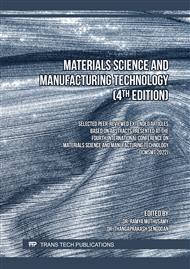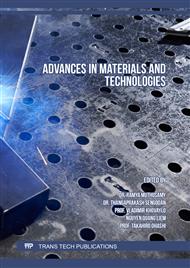[1]
J. Huang, and Q.Wan, Gas sensors based on semiconducting metal oxide one-dimensional nanostructures. Sensors, 9 (2009) 9903-9924.
DOI: 10.3390/s91209903
Google Scholar
[2]
Yulia Borchert, Patrick Sonstrom, Michaela Wilhelm, Holger Borchert, and Marcus Ba1umer, Nanostructured Praseodymium Oxide: Preparation, Structure, and Catalytic Properties, J. Phys. Chem. C, 112 (2008) 3054-3063.
DOI: 10.1021/jp0768524
Google Scholar
[3]
M. A. Pinheiro, T. F. Pineiz, E. A. de Morais, L. V. Scalvi, M. J. Saeki, and A. A.Cavalheiro, Schottky emission in nanoscopically crystallized Ce-doped SnO2 thin films deposited by sol–gel-dip-coating. Thin Solid Films, 517 (2008) 976-981.
DOI: 10.1016/j.tsf.2008.07.001
Google Scholar
[4]
B.Thomas, S. Deepa, & K. P. Kumari, Influence of surface defects and preferential orientation in nanostructured Ce-doped SnO2 thin films by nebulizer spray deposition for lowering the LPG sensing temperature to 150° C. Ionics, 25(2019) 809-826.
DOI: 10.1007/s11581-018-2732-y
Google Scholar
[5]
W. Q. Li, S. Y. Ma, Y. F. Li, X. B. Li, C. Y. Wang, X. H. Yang, ... and X. L. Xu, Preparation of Pr-doped SnO2 hollow nanofibers by electrospinning method and their gas sensing properties. Journal of alloys and compounds, 605(2014) 80-88.
DOI: 10.1016/j.jallcom.2014.03.182
Google Scholar
[6]
F. H. Aragón, I. Gonzalez, J. A. Coaquira, P. Hidalgo, H. F. Brito, J. D. Ardisson, ... & P. C. Morais, Structural and surface study of praseodymium-doped SnO2 nanoparticles prepared by the polymeric precursor method. The Journal of Physical Chemistry C, 119 (2015) 8711-8717.
DOI: 10.1021/acs.jpcc.5b00761
Google Scholar
[7]
S. Deepa, K. PrasannaKumari, & B. Thomas, Influence of lattice strain and dislocations on the LPG sensing performance of praseodymium doped SnO2 nanostructured thin films. IJRASET, 5 (2017) 1054-1059.
DOI: 10.22214/ijraset.2017.9152
Google Scholar
[8]
S. Deepa, B.Thomas, & K.PrasannaKumari, Influence of surface oxygen vacancies on the LPG sensing response and the gas selectivity of Nd-doped SnO2 nanoparticulate thin films. Journal of Materials Science: Materials in Electronics, 30 (2019) 16579-16595.
DOI: 10.1007/s10854-019-02037-x
Google Scholar
[9]
Y. M. Chiang, D. P. Birnie, and W. D. Kingery, Physical Ceramics: Principles for Ceramic Science and Engineering. J. Wiley, New York, (1997) 357-358.
Google Scholar
[10]
Boben Thomas, Benoy Skariah, Spray deposited Mg-doped SnO2 thin film LPG sensor: XPS and EDX analysis in relation to deposition temperature and doping, 625 (2015) 231–240.
DOI: 10.1016/j.jallcom.2014.11.092
Google Scholar
[11]
B. D. Cullity, Elements of X-Ray diffraction, Addision-Wesley, New York, (1978).
Google Scholar
[12]
A. K. Singh, A. Janotti, M. Scheffler and C. G. Van de Walle, Sources of electrical conductivity in SnO2.Physical Review Letters, 101 (2008) 055502.
Google Scholar
[13]
S., Deepa, K. P. Kumari, & B. Thomas, Contribution of oxygen-vacancy defect-types in enhanced CO2 sensing of nanoparticulate Zn-doped SnO2 films. Ceramics International, 43 (2017) 17128-17141.
DOI: 10.1016/j.ceramint.2017.09.134
Google Scholar
[14]
S. Sagadevan, and C. Arunseshan, Dielectric properties of cadmium selenide (CdSe) nanoparticles synthesized by solvothermal method. Applied Nanoscience, 4 (2014)179-184.
DOI: 10.1007/s13204-012-0186-5
Google Scholar
[15]
J. Liu, X. Huang, G. Ye, W. Liu, Z. Jiao, W. Chao, Z. Zhou and Z. Yu, H2S detection sensing characteristic of CuO/SnO2 sensor.Sensors, 3 (2003) 110-118.
DOI: 10.3390/s30500110
Google Scholar
[16]
N. B. Sonawane, K. V. Gurav, R. R. Ahire, J. H. Kim and B. R. Sankapal, CdS nanowires with PbS nanoparticles surface coating as room temperature liquefied petroleum gas sensor. Sensors and Actuators A: Physical, 216 (2014) 78-83.
DOI: 10.1016/j.sna.2014.05.012
Google Scholar
[17]
T. Nakahara, H. Koda; Chemical Sensor Technology, Vol. 3 (Kodansha and Elsevier, Amsterdam, (1992).
Google Scholar
[18]
N. Barsan, U. W. Eimar, Conduction model of metal oxide gas sensors, Journal of Electro ceramics 7 (2001) 143-167.
Google Scholar
[19]
R.K Mishra, P.P Sahay, Zn-doped and undoped SnO2 nano particles: A comparative structural, optical and LPG sensing properties study, Materials Research Bulletin 47 (2012) 4112-4118.
DOI: 10.1016/j.materresbull.2012.08.051
Google Scholar
[20]
A. Srivastava, S. T. Lakshmikumar, A. K. Srivastava and K. Jain, Gas sensing properties of nanocrystalline SnO2 prepared in solvent media using a microwave assisted technique. Sensors and Actuators B: Chemical, 126 (2007) 583-587.
DOI: 10.1016/j.snb.2007.04.006
Google Scholar
[21]
D. Haridas, A. Chowdhuri, K. Sreenivas, and V. Gupta, Enhanced room temperature response of SnO2 thin film sensor loaded with Pt catalyst clusters under UV radiation for LPG. Sensors and Actuators B: Chemical,153 (2011)152-157.
DOI: 10.1016/j.snb.2010.10.024
Google Scholar
[22]
R.K. Mishra, P.P Sahay, Materials Research Bulletin 47 (2012) 4112-4118.
Google Scholar
[23]
M. N. Rumyantseva, A. M. Gaskov, N. Rosman, T. Pagnier and J. R. Morante, Raman surface vibration modes in nanocrystalline SnO2: correlation with gas sensor performances. Chemistry of materials, 17 (2005) 893-901.
DOI: 10.1021/cm0490470
Google Scholar
[24]
J.G. Traylor, H.G. Smith, R.M. Nicklow, and M.K. Wilkinson, Lattice dynamics of rutile. Physical Review B, 3 (1971) 3457-3472.
DOI: 10.1103/physrevb.3.3457
Google Scholar
[25]
M. Batzill, and U. Diebold, The surface and materials science of tin oxide.Progress in surface science, 79 (2005) 47-154.
DOI: 10.1016/j.progsurf.2005.09.002
Google Scholar
[26]
F. H. Aragón, J.A.H. Coaquira, P. Hidalgo, S.L.M., Brito, D. Gouvêa, and R. H. R. Castro, Structural and magnetic properties of pure and nickel doped SnO2 nanoparticles. Journal of Physics: Condensed Matter, 22 (2010) 496003.
DOI: 10.1088/0953-8984/22/49/496003
Google Scholar
[27]
P. Thangadurai, A. C. Bose, S. Ramasamy, Kesavamoorthy, and T. R. Ravindran, High Pressure effects on electrical resistivity and dielectric properties of nanocrystalline SnO2.Journal of Physics and Chemistry of Solids, 66 (2005) 1621-1627.
DOI: 10.1016/j.jpcs.2005.05.079
Google Scholar
[28]
W.Z. Wang, C.K. Xu, G.H. Wang, Y.K., Liu and C.L. Zheng, Preparation of Smooth Single Crystal Mn3O4 Nanowires. Advanced Materials, 14 (2002) 837-840.
DOI: 10.1002/1521-4095(20020605)14:11<837::aid-adma837>3.0.co;2-4
Google Scholar
[29]
S. Luo, P. K. Chu, W. Liu, M. Zhang and C. Lin, Origin of low-temperature photoluminescence from SnO2 nanowires fabricated by thermal evaporation and annealed in different ambients. Applied Physics Letters, 88 (2006)183112.
DOI: 10.1063/1.2201617
Google Scholar
[30]
Nguyen VnHieu, Le Thi Ngoc Loan, Nguyen DucKhoang, Nguyen Tuan Minh, Do Thanh Viet, Do Cong Minh, Tran Trung and Nguyen Duc Chien. A facile thermal evaporation route for large-area synthesis of tin oxide nano wires: Characterisations and their use for liquid petroleum gas sensor. Current Applied Physics, 10 (2010) 636-641.
DOI: 10.1016/j.cap.2009.08.008
Google Scholar
[31]
A. Kar, M. A. Stroscio, M. Dutta, J. Kumari, and M. Meyyappan, Observation of ultraviolet emission and effect of surface states on the luminescence from tin oxide nanowires. Applied Physics Letters, 94 (2009) 101905.
DOI: 10.1063/1.3097011
Google Scholar
[32]
H.T. Chen, S.J. Xiong, X.L. Wu, J. Zhu, J.C. Shen and P.K. Chu, Tin oxide nanoribbons with vacancy structures in luminescence-sensitive oxygen sensing. Nano letters, 9 (2009) 1926-1931.
DOI: 10.1021/nl900075f
Google Scholar



